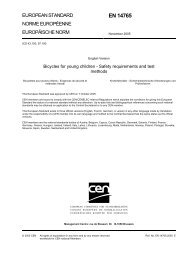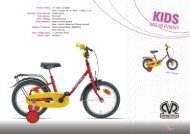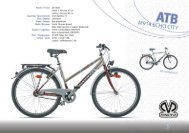EN 14766:2005 - 64_e_stf - Baltik vairas
EN 14766:2005 - 64_e_stf - Baltik vairas
EN 14766:2005 - 64_e_stf - Baltik vairas
- No tags were found...
You also want an ePaper? Increase the reach of your titles
YUMPU automatically turns print PDFs into web optimized ePapers that Google loves.
<strong>EN</strong> <strong>14766</strong>:<strong>2005</strong> (E)4.13.6.2.3 Multi-speed systema) Conduct the tests described in 4.13.6.2.2 with the transmission correctly adjusted in its highest gear;b) conduct the tests generally as described in 4.13.6.2.2 with the transmission correctly adjusted in its lowestgear but, where appropriate, with the maximum force, F, adjusted to suit the particular gear ratio, thus:The maximum force, F, shall be a function of the lowest gear ratio, N c /N swhereF is the force applied to the pedal, N;N c is the number of teeth on the smallest chain-wheel (front);N s is the number of teeth on the largest sprocket (rear).Where the ratio N c /N s has a value equal to or greater than one, the force, F, shall be 1 500 N, but where the ratioN c /N s has a value less than one, the force, F, shall be reduced in proportion to the lowest gear ratio thus:F = 1 500 x N c /N s4.13.7 Crank assembly – fatigue tests4.13.7.1 GeneralTwo types of fatigue test are specified, one with the cranks positioned at 45° to the horizontal to simulate the forcesdue to pedalling, and the second test with the cranks positioned at 30° to the horizontal which has been found tosimulate the forces due the rider standing on the pedals during the descent of hills. The two tests shall beconducted on separate assemblies.If the pedal-spindles are too short for the test forces to be applied 65 mm from the outer faces of the crankssuitable extensions shall be fitted to the spindles for the purpose of the test.4.13.7.2 RequirementWhen tested by the methods described in 4.13.7.3 and 4.13.7.4, there shall be no fractures or visible cracks in thepedal-spindles, the cranks, the bottom-bracket spindle or any of the attachment features, or loosening ordetachment of the chain-wheel from the crank.For carbon-fibre cranks, the peak deflection of either crank during the test shall not increase by more than 20 % ofthe initial value.4.13.7.3 Test method with the cranks at 45° to the horizontalMount the assembly of the two pedal-spindles (with extension adaptors if necessary), the two cranks, the chainwheelset (or other drive component), and the bottom-bracket spindle located on its normal-production bearings ina fixture with bearing-housings representative of the bottom-bracket, as shown in Figure 46. Incline the cranks at45° to the horizontal. Prevent rotation of the assembly by locating a suitable length of drive-chain around thelargest or only chain-wheel and securing it firmly to a suitable support, or, for any other type of transmission (e.g.belt- or shaft-drive) by securing the first stage of the transmission.NOTE It is permissible to have the left crank in either of the two positions shown in Figure 46, provided the test force isapplied in the appropriate direction as specified in the next paragraph.Apply repeated, vertical, dynamic forces of 1 800 N alternately to the pedal-spindles of the left- and right-handcranks at a distance of 65 mm from the outboard face of each crank (as shown in Figure 46) for 50 000 cycles(where one test cycle consists of the application of the two forces). The direction of the force on the right-handcrank shall be downwards and that on the left-hand crank shall be upwards for a rearward-pointing crank ordownwards for a forward-pointing crank. During applications of these test forces, ensure that the force on a pedal-71







